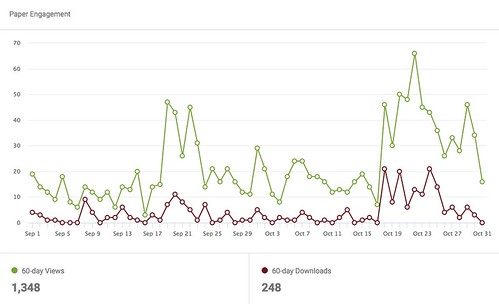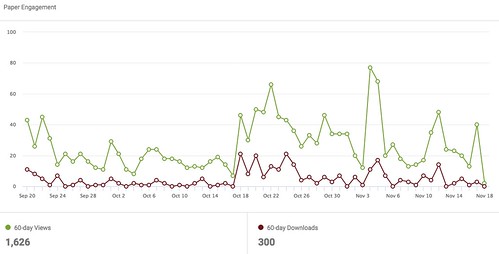On Oct. 31 I posted this chart in a post that was otherwise about Donald Trump and his tweeting activity:
The chart depicts action on my page at Academica.edu, my main repository of articles and working papers. The green (upper) line shows how many papers views I got each day while the brown (lower) line shows downloads.
The point of the chart is that there are two periods of markedly increased activity, activity caused by my deliberate and conscious action. I then asked: “What are the chances that I can keep it going? Off hand, not good. I just don’t have that much of what seems to be the right material to keep it going.” That is, I knew what I did to drive the numbers up but I wasn’t prepared to keep doing that.
This chart depicts my action as of November 16 and 10:32 PM:
That certainly looks like I’ve managed to keep the action up for roughly the past month. To be sure, the action is spiky but it does appear that, on average, interest is up.
Here’s a chart I grabbed at 5:52 this morning, November 19, 2018:
We’ve got a new spike there at the right edge of the chart. While it’s low in relation to the action for Nov 4 and 5, the high point of the chart (and I forget just what I did to produce that), it’s high in relation to the chart as a whole and, in particular, it’s in the range of the mid-September action that started this roll (and which is now trailing off the left edge of the graph).
I know exactly what I did this time. I sent the following note to the Humanist Discussion Group:
I don’t know how old you are, Jim (if i may), but I’ll be 71 in a few weeks and was publishing on literature and computation in the mid-1970s:
"Cognitive Networks and Literary Semantics", MLN 91: 1976, 952-982. Here I used a computational model to examine the semantic structure of Shakespeare’s sonnet 129. There’s a downloadable version of that article here: https://www.academia.edu/235111/Cognitive_Networks_and_Literary_Semantics
That same year David Hays and I published this, “Computational Linguistics and the Humanist”, Computers and the Humanities, Vol. 10. 1976, pp. 265-274. There we proposed something we called Prospero, a computer system for reading Shakespeare in some interesting way. Alas, the more we learn about both computing and about the mind/brain, the most distant that Prospero seems, but still, it’s worth thinking about. You can download that here: https://www.academia.edu/1334653/Computational_Linguistics_and_the_Humanist
Best,
Bill Benzon
That recent spike consists mostly of interest in those two papers, which is much stronger on views than actual downloads (as is generally the case).
I have no idea what will happen today. Of course, I do expect the numbers to rise above the floor, after all it’s 6 AM here on the East Coast of the USA, but just how high they’ll go, I still don’t know. Nor will I hazard a prediction about the future. But I’m pretty sure that if I want to keep the numbers up, I’ve got to upload a paper to the “sweet zone” pretty soon, and I don’t have anything that’s quite ready for upload.
We’ll see.



No comments:
Post a Comment